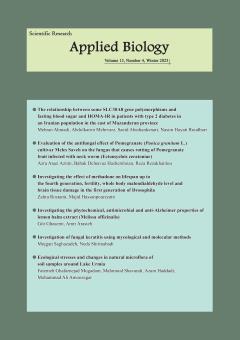Isolation and identification of extremophile bacteria producing anti-cancer enzyme L-asparaginase from Yale Gonbad hot spring
Subject Areas : biology
Shaghayegh Kashef Haghighat
1
![]() ,
Elaheh Ali-Asgari
2
*
,
Elaheh Ali-Asgari
2
*
![]()
1 - Master's degree, Department of Biology, Tehran East Branch, Islamic Azad University, Tehran, Iran
2 - Assistant Professor, East Tehran Branch, Islamic Azad University, Tehran, Iran
Keywords: Extremophile bacteria, L-asparaginase, Anti-cancer enzyme, Yale Gonbad hot spring.,
Abstract :
Purpose: The most abundant sources used to obtain enzymes with greater stability are thermophilic bacteria. In recent years, microbial L-asparaginase has been widely used as a therapeutic agent in the treatment of human cancers. It is also recently used in the treatment of acute lymphoblastic leukemia. In this regard, the aim of this study is to screen new thermophilic strains capable of producing L-asparaginase enzymes.
Materials and methods: Yale Gonbad hot spring was chosen as the isolation site
for thermophilic bacteria. Cultivation and morphological and biochemical tests were
done to identify the strain. The bacterial strain was screened in order to investigate
L-asparaginase enzyme activity by (RPA) method. Modified M9 medium containing
L-asparagine and phenol red was used as reagent. Finally, a bacterial strain was identified by determining the 16RrRNA gene sequence after PCR.
Findings: Finally, a thermophilic strain was isolated from Yale Gonbad hot spring, which belonged to Bacillus licheniformis. L-asparaginase activity was observed in YT strain and Bacillus licheniformis was produced.
Conclusion: Yale Gonbad hot spring is one of the sources with high potential of useful microbial products that can be used as a useful source of many biological products such as enzymes.
1. Kiani K. Properties of Therapy Warm and Healing mineral water of Iran with addresses and locations. Zar ghalam publication; 2008: 304. [in persian]
2. Appel IM, van Kessel-Bakvis C, Stigter R & Pieters R. Influence of two different regimens of concomitant treatment with asparaginase and dexamethasone on hemostasis in childhood acute lymphoblastic. Leukemia. 2007; 21(11): 2377. https://doi.org/10.1038/sj.leu.2404793
3. Bessoumy AA, Mohamed, S & Jehn M. Production, Isolation, and Purification of
L-asparaginase from Pseudomonas Aeruginosa 50071 Using Solid-stateFermentation. Journal of Biochemistry and Molecular Biology. 2008; 37(4): 387-393.
4. Rafi MD. Evaluation of antioxidant, cytotoxic and thrombolytic activity of kalanchoepinnata leaf. World journal of pharmacy and pharmaceutical sclences. 2014; 3(6): 52-62.
5. Nandakumar R, Yoshimune K, Wakayama M & Moriguchi M. Microbial glutaminase: biochemistry, molecular ap-proaches and applications in the food industry. J. Mol.Catal.B Enzym. 2003; 23: 87-100.
6. Ramesh S & Mathivanan N. Screening of marine Actinomycetes isolated from the Bay of
Bengal, India for antimicrobial activity and industrial enzymes. World J Microb Biot. 2009; 25(12): 2103-2111.
7. Akmar HN, Asma I, Venugopal B, Latha LY & Sasidharan S. Identification of appropriate sample and culture method for isolation of new thermophilic bacteria from hot spring. African Journal of Microbiology Research. 2011; 5: 217-221.
8. Gulati R, Saxena R & Gupta R. A rapid plate assay for screening L- asparaginase producing microorganisms. Lett Appl Microbiol. 1997; 24(1): 23-26.
9. Nimnoi P, Pongsilp N & Lumyong S. Endophytic Actinomycetes isolated from Aquilaria
crassna, Pierreex lec and screening of plant growth promoters’ production. World J Microbiol Biot. 2010; 26(2): 193-203.
10. Abkhoi L, Minaei Tehrani D, Kolahdouz Mohammadi, M, Iftikhar F, Karaji N, Mir Fakhar F & Waziri Tabar N. Purification and determination of kinetic properties of asparaginase enzyme in Serratia marcescens. Journal of Cell and Molecular Research. 2014; 3(6).
[in persian]
11. Garaev MM & Golub EI. Mechanism of the effect of glucose on Lasparaginse synthesis by Escherichia coli bacteria. Mikrobiologia. 1977; 46(3): 433-439.
12. Savitri N, Asthana N & Azmi W. Microbial L-asparaginase: a potent antitumour enzyme. Indian J Biotechnol. 2002; 2(2): 184-194.
13. Tong WH & et al. Cost tanalysis of treatment of childhood acute lymphoblastic leukemia with asparationase preparations: the impact of expensive chemotherapy. Haematologica. 2013; 98(5): 753-9. https://doi.org/10.3324/haematol.2012.073510
14. Paglla K & Cooksey E. Regulation of L- asparaginase EC-3.5.1.1 in a chlamydomonas species in response to ambient concentration of combined nitrogen. Journal of Bacteriology. 2013; 147(1): 9-12.
15. Kumari P, Sankar G & Prabhakar T. L- asparaginase production and molecular identification of marine Streptomycete strain WS3/1. Int J Pharm Biomed Res. 2012; 2(4): 244-249.
16. Ebrahiminezhad A, Rasoul-amini S & Ghasemi Y. L- asparaginase production by moderate halophilic bacteria isolated from Maharloo Salt Lake. Indian J Microbiol. 2011; 51(3):
307-311.
17. Peterson RE & Ciegler A. L-Asparaginase Production by Erwinia aroideae, Environ. Microbiol. 2011; 18(1): 64-67. https://doi.org/10.1128/am.18.1.64-67.1969

